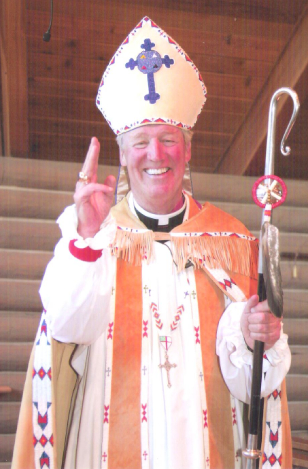by Craig B. Anderson
At the conclusion of my adoption rite into an extended family (Tiyospaye) of the Oglala tribe of the Great Sioux Nation, I was given an eagle feather attached to a Lakota Prayer Wheel with this admonition from a Lakota Medicine man:
“You have been given a very high and noble name, that of Wanbli Tokaheya which means, Leading Eagle. The eagle is a spiritual bird and has a special meaning for the Lakota people and the Oglala tribe. As a holy creature empowered with vision, the name Wanbli Tokaheya is a reminder and an expectation that you are called as our Bishop and adopted member of this tribal family to be a holy man and a person of vision. This eagle feather is a reminder of that calling and is attached to a prayer wheel which is a symbol that should guide you among us. The prayer wheel is a sacred hoop which contains within it the four directions which point to the four virtues, the four colors, and the four elements.”
The admonition, eagle feather and prayer wheel served to guide me as the eighth Bishop of The Diocese of South Dakota. The symbol of the circle, or sacred hoop helped me to frame the ministry of reconciliation given the racial tension that characterizes life in the state of South Dakota. The cruciform nature of the four directions within the circle of unity were and are ongoing reminders of the need for differentiation and an awareness of reconciliation itself as cruciform. The foundation for such ministry is prayer. Prayer, however, is understood differently by the Lakota people. I now turn in the four directions to this difference as embodied in the prayer wheel: Prayer is central to and permeates all of Lakota life and culture. As such, prayer is not confined to liturgical or ritual occasions. Prayer is not confined to one or two times during the day nor to one day of the week. Unlike our culture, Lakota culture makes no distinction or separation between church and state. All of life and all of creation is seen as sacred, as holy, as wakan.
Second, and related to this first aspect of Lakota spirituality, is the fact that prayer defines one’s place within the community and creation. The sacred circle/hoop is a sign of unity, harmony and inclusiveness encompassing the four directions in which prayer is offered. On its vertical axis, prayer is offered to the great spirit, Wakan Takan in its most personal form as Tukasila, (Grandfather). But such prayer also includes a reverence and respect for Maka, the earth, our mother (Ina). As devout incarnationalists, Lakota people experience God in all of life. Nowhere is this more clearly seen than in the gathering of the community by orators, tribal leaders, politicians, and preachers who traditionally begin their address with the prayer, Mitakuye Owasin, which means, “we are all relatives,” or “we are all related.” Such a recognition is a prayerful reminder of the relatedness and the interdependence of all life in recognizing that “all my relatives,” include the four-legged, the winged and the finned creatures of God.
The vertical dimension of prayer discloses a continuum in uniting the sacred and the secular, the extra-ordinary and the ordinary, heaven and earth. Such a dimension requires completion in praying horizontally for others and oneself. Praying for others and oneself on this horizontal level presupposes prayer grounded in the Other of the vertical plane. To recall Martin Buber, “before me, there is a Thee and a Thou.”
This second recognition leads to a third awareness from Lakota culture; while prayer is seen as an action and an utterance on the part of the community and the individual, it has been my experience that in its most basic form, Lakota prayer more accurately describes a disposition, posture or openness to the Other by an awareness of the other. Contrasted to our culture of incessant speaking and constant noise, silence is the primary mode of prayer in Lakota culture. The vision quest, the sweat lodge, the sun dance and other major sacramental rites of Lakota religious practice contain within them a preeminent place for silence. Such a silence reveals the need for a patient receptivity in the presence of the Holy. Such a posture and disposition serves to correct our constant need to be active in our attempts to control God through prayer. As one sociologist of religion put it, “the greatest contribution that Lakota religious practice and spirituality make is its sense of seeing the individual in his or her rightful place n the created order and not at the center of creation as in Western Christianity’s anthropocentric understandings of human being.
Fourth and finally, the Lakota prayer wheel suggests a completion of our oft-cited and rehearsed credo as Anglicans, “Lex orandi, Lex crendio,” the law of praying is the law of believing. The sacred hoop suggests and expansion of this creed: ‘the law of praying leads to the law of profession (belief) which in turn leads to the necessity for proclamation, in both word and action which finally results in praxis (the integration of theory and action).” Such four-fold directionality within a hermeneutical circle of interpretation, informed by prayer, eventuates as praxis or Christian living.
One of the obligations of Lakota adoption, is to pray for one’s Tiyospaye or extended family. In attaching the prayer wheel and eagle feather to my pastoral staff, I am reminded as a Bishop that all ministry is grounded in prayer and that such prayer is cruciform and is offered for the harmony, unity, redemption, and reconciliation of all of God’s creation.
Note on author:
Craig B. Anderson, Ph.D., eighth Bishop of The Episcopal Diocese of South Dakota was recently called to be the President and Dean of the General Theological Seminary of the Episcopal Church in New York City.

